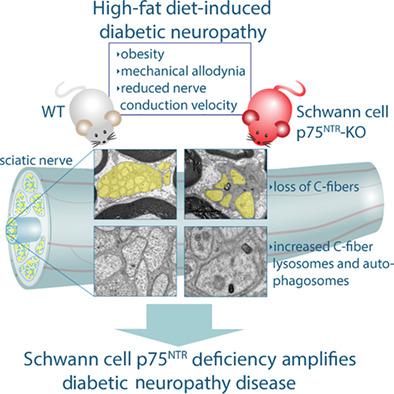Our official English website, www.x-mol.net, welcomes your
feedback! (Note: you will need to create a separate account there.)
Schwann cell p75 neurotrophin receptor modulates small fiber degeneration in diabetic neuropathy.
Glia ( IF 5.4 ) Pub Date : 2020-07-13 , DOI: 10.1002/glia.23881 Nádia P Gonçalves 1, 2 , Sara E Jager 1, 3 , Mette Richner 1 , Simon S Murray 4 , Simin Mohseni 5 , Troels S Jensen 2, 6 , Christian B Vaegter 1, 2
Glia ( IF 5.4 ) Pub Date : 2020-07-13 , DOI: 10.1002/glia.23881 Nádia P Gonçalves 1, 2 , Sara E Jager 1, 3 , Mette Richner 1 , Simon S Murray 4 , Simin Mohseni 5 , Troels S Jensen 2, 6 , Christian B Vaegter 1, 2
Affiliation

|
Diabetic neuropathy has an incidence as high as 50% of diabetic patients and is characterized by damage to neurons, Schwann cells and blood vessels within the peripheral nervous system. The low‐affinity neurotrophin receptor p75 (p75NTR), particularly expressed by the Schwann cells in the peripheral nerve, has previously been reported to play a role in developmental myelination and cell survival/death. Increased levels of p75NTR, in the endoneurium and plasma from diabetic patients and rodent models of disease, have been observed, proposing that this receptor might be involved in the pathogenesis of diabetic neuropathy. Therefore, in this study, we addressed this hypothesis by utilizing a mouse model of selective nerve growth factor receptor (Ngfr) deletion in Schwann cells (SC‐p75NTR‐KO). Electron microscopy of sciatic nerves from mice with high fat diet induced obesity demonstrated how loss of Schwann cell–p75NTR aggravated axonal atrophy and loss of C‐fibers. RNA sequencing disclosed several pre‐clinical signaling alterations in the diabetic peripheral nerves, dependent on Schwann cell p75NTR signaling, specially related with lysosome, phagosome, and immune pathways. Morphological and biochemical analyses identified abundant lysosomes and autophagosomes in the C‐fiber axoplasm of the diabetic SC‐p75NTR‐KO nerves, which together with increased Cathepsin B protein levels corroborates gene upregulation from the phagolysosomal pathways. Altogether, this study demonstrates that Schwann cell p75NTR deficiency amplifies diabetic neuropathy disease by triggering overactivation of immune‐related pathways and increased lysosomal stress.
中文翻译:

施万细胞 p75 神经营养因子受体调节糖尿病神经病变中的小纤维变性。
糖尿病神经病变在糖尿病患者中的发病率高达 50%,其特点是周围神经系统内的神经元、雪旺氏细胞和血管受损。低亲和力神经营养因子受体 p75 (p75 NTR ),特别是由外周神经中的雪旺氏细胞表达,先前已报道在发育髓鞘形成和细胞存活/死亡中发挥作用。已经观察到糖尿病患者和啮齿动物疾病模型的神经内膜和血浆中 p75 NTR水平升高,这表明该受体可能参与糖尿病神经病变的发病机制。因此,在本研究中,我们通过利用选择性神经生长因子受体 ( Ngfr) 雪旺氏细胞中的缺失 (SC-p75 NTR - KO)。高脂肪饮食诱导肥胖小鼠坐骨神经的电子显微镜检查表明,雪旺氏细胞-p75 NTR 的丢失如何加剧轴突萎缩和 C 纤维的丢失。RNA 测序揭示了糖尿病周围神经的几个临床前信号改变,依赖于雪旺细胞 p75 NTR信号,特别是与溶酶体、吞噬体和免疫通路相关。形态学和生化分析在糖尿病 SC-p75 NTR的 C 纤维轴浆中鉴定出丰富的溶酶体和自噬体‐KO 神经与增加的组织蛋白酶 B 蛋白水平一起证实了来自吞噬溶酶体途径的基因上调。总之,这项研究表明,雪旺细胞 p75 NTR缺乏通过触发免疫相关通路的过度激活和溶酶体应激增加来放大糖尿病神经病变。
更新日期:2020-07-13
中文翻译:

施万细胞 p75 神经营养因子受体调节糖尿病神经病变中的小纤维变性。
糖尿病神经病变在糖尿病患者中的发病率高达 50%,其特点是周围神经系统内的神经元、雪旺氏细胞和血管受损。低亲和力神经营养因子受体 p75 (p75 NTR ),特别是由外周神经中的雪旺氏细胞表达,先前已报道在发育髓鞘形成和细胞存活/死亡中发挥作用。已经观察到糖尿病患者和啮齿动物疾病模型的神经内膜和血浆中 p75 NTR水平升高,这表明该受体可能参与糖尿病神经病变的发病机制。因此,在本研究中,我们通过利用选择性神经生长因子受体 ( Ngfr) 雪旺氏细胞中的缺失 (SC-p75 NTR - KO)。高脂肪饮食诱导肥胖小鼠坐骨神经的电子显微镜检查表明,雪旺氏细胞-p75 NTR 的丢失如何加剧轴突萎缩和 C 纤维的丢失。RNA 测序揭示了糖尿病周围神经的几个临床前信号改变,依赖于雪旺细胞 p75 NTR信号,特别是与溶酶体、吞噬体和免疫通路相关。形态学和生化分析在糖尿病 SC-p75 NTR的 C 纤维轴浆中鉴定出丰富的溶酶体和自噬体‐KO 神经与增加的组织蛋白酶 B 蛋白水平一起证实了来自吞噬溶酶体途径的基因上调。总之,这项研究表明,雪旺细胞 p75 NTR缺乏通过触发免疫相关通路的过度激活和溶酶体应激增加来放大糖尿病神经病变。











































 京公网安备 11010802027423号
京公网安备 11010802027423号